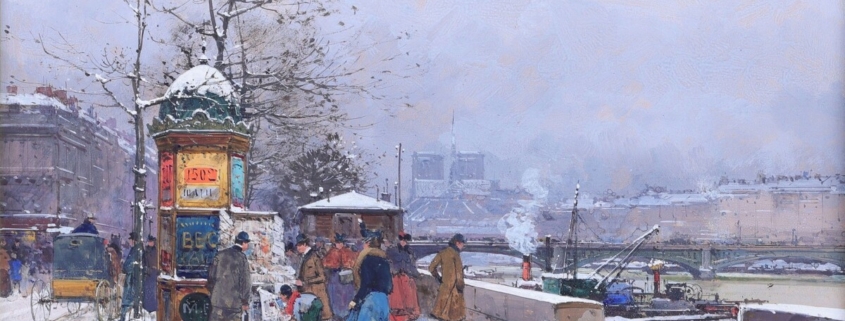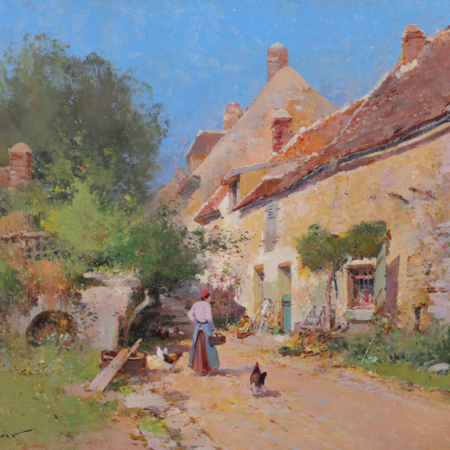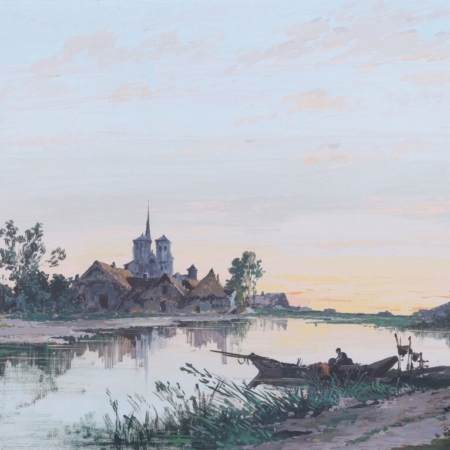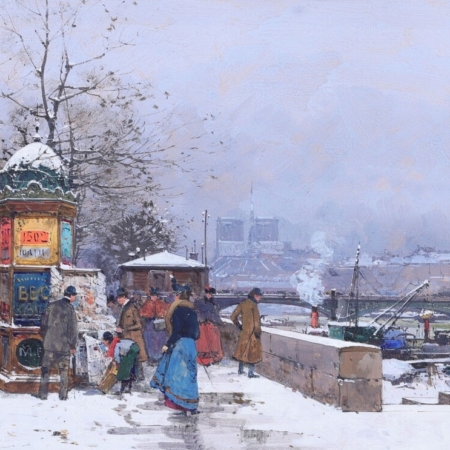
Eugene Galien-Laloue
Eugène Galien Laloue was particularly adept at establishing several identities, since over the course of his career he worked under many pseudonyms eg J. Lievin, E. Galiany, L. Dupuy, E. Bardin and Dominique. While these are confirmed names that he used, there is the possibility that he used other names as well. Why the artist went to such great lengths to perplex audiences and historians is the question that remains to be answered. Despite preoccupation with the reclusive nature of this man, he depicted Paris and the surrounding landscape with his cool palette; in doing so he became another recorder of popular Parisian life. He balanced his architectural interest in Paris with several landscape views and was an equally if not more proficient draughtsman.
Born in Paris on December 11, 1854 to Charles and Endoxie Laloue. Eugène was the oldest of 9 children and when his father died in 1870, he had to leave his studies and find a job. In 1871 he enlisted in the army and by 1874, after serving in the war through the end of the Franco-Prussian war of 1870-1871, the French Railway hired him as an illustrator depicting the rail track that was being laid from Paris to the provinces. Concurrently he began painting the surrounding landscapes as well. He began painting views of Paris and exhibited for the first time in 1876 at the Museum of Reims, showing Le quai aux fleurs par la neige (Flower Market along the Seine under the Snow). The following year he exhibited for the first time at the annual Parisian Salon, showing En Normandie(In Normandy) as well as two gouaches. He preferred executing gouaches since they were less time consuming as his oils and brought comparable prices. By 1878 he was exhibiting at the Salon and became a frequent exhibitor through 1889, displaying both Paris street scenes and views in Normandy. From the beginning of his career and perhaps spurred by his travels along the railway lines, Galien Laloue became interested in showing the natural environment however whilst his Parisian views are commonplace, as are his sometimes poorly executed landscapes.
In 1887 his wife, Flore Bardin, passed away and he and his son Fernand were on their own in Paris. He had a reclusive personality, which also may explain the reasons behind his numerous pseudonyms. He preferred the solitariness of his studio and thus did not paint his works entirely on-site. He did not like to travel and many of his views of other cities or countries were inspired by postcards and photographs.
His personality kept him at a distance from his contemporaries who were working in his same manner. He was more concerned with the sale of his paintings, of which he kept scrupulous notes but still sold each painting for the same price. He was an active participant in the annual Parisian Salons until 1889 where he exhibited two gouaches Bernay (Bernay), and Bords de la Meuse (Banks of the Meuse). By 1892 Eugène had met, and married, Ernestine Bardin; one year later the couple had a child – Flore Marie After this point he took a five year sabbatical during which time his daughter was born, and by the turn of the century it appears that the family was living in Fontainebleau and in 1904 Eugène, once again, began exhibiting at the Paris Salon, along with exhibitions throughout the country, including: Toulon, Angers, St. Quentin, Roubaix, Dijon, Saint-Etienne, Monte Carlo, Nogent sur Marne and Bordeaux.
As World War I broke out, he was exempt from military service because he had volunteered for the Franco-Prussian war. He was too old to take part in the war. Instead, he took to his canvas and depicted scenes of soldiers in the midst of battle, paying close attention to the setting and other details such as their costumes and the action of their involvement. His own previous military experience must have inspired his depictions, since in his military scenes his figures are given a more prominent role than in either his Parisian scenes or his landscape paintings. He identified with these soldiers.
His daughter, Flore was married in 1919 and in 1925 his second wife Ernestine passed away. After the death of his third wife, Eugène moved back to Paris to live with his daughter where he remained until the evacuation of Paris in 1940 when the family fled to Bordeaux. Eugène died the following year.
Click on the images below to view and purchase our paintings by Eugene Galien-Laloue…
- Display 24 Products per page



